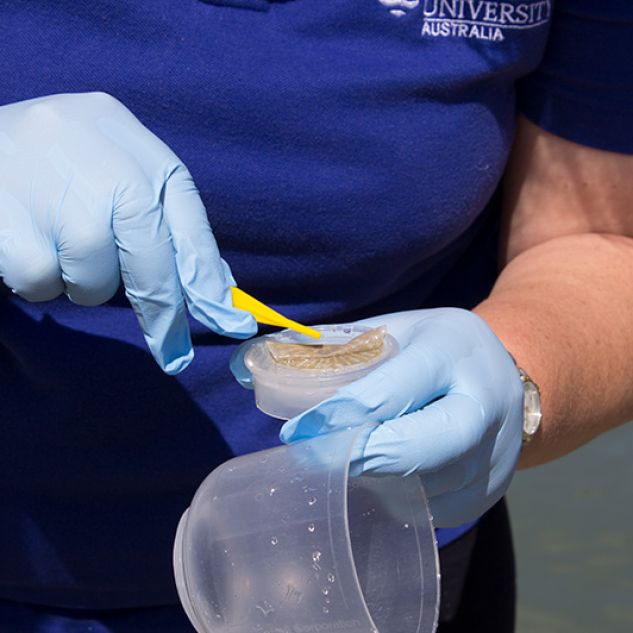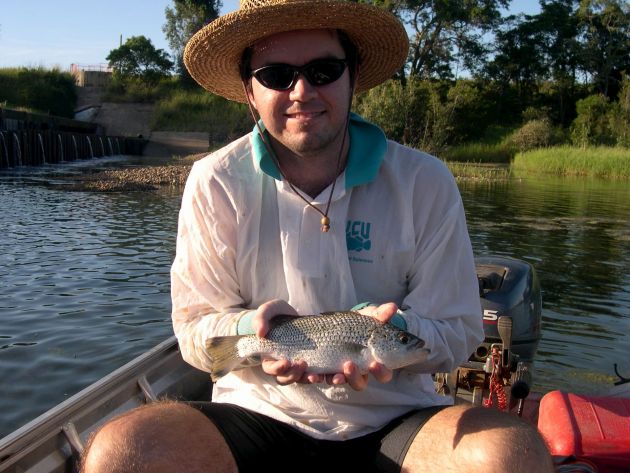The future of biology
What if you could know exactly which animals have passed through a particular area, based solely on the minute traces of DNA they shed? A revolution in biology has arrived, and it’s set to change everything about how we monitor rare and invasive species around the world.
Imagine a future where a small electronic device could identify every species that’s passed through your local area in recent days. Rare animals or dangerous pests, thriving species or those in collapse– all could be accounted for, based on the tiny fragments of skin, fur, or scales that these creatures shed on their way through.
That future is not far off, thanks to an emerging technique known as environmental DNA – or eDNA.
“This is a revolution in biology,” says Professor Damien Burrows, Director of the TropWATER research centre at James Cook University (JCU).
“You can confirm the presence of animals or plants without ever actually seeing them. It’s going to enormously magnify the amount of information we get on the distribution of every organism. The amount of data we’re going to be able to collect will simply blow us away.”
What is eDNA?
All organisms shed DNA into the environment, and scientists are now able to scan a sample of water, air, or soil to trace these tiny remnants.
“When organisms die, their bodies decay and leave DNA traces. But living animals also shed DNA through their mucus, faeces, urine, and skin cells,” Professor Burrows explains.
“If you’re a fish, this happens through dropping scales, and also through the distribution of sex cells (gametes) in the water. And if an animal gets eaten, body parts go flying, and their genetic material can be identified in a sample.”
How does eDNA work?
According to Professor Burrows, there are two methods for identifying sources of eDNA:
- If you’re looking for a specific species in your sample, that’s referred to as DNA Barcoding – you’re using a specific gene test to target a single species.
- If you want to identify all the species in the sample, that’s called DNA Metabarcoding.
“That’s the ultimate goal,” says Professor Burrows. “We need to know everything that’s living in a particular area.”
In the early days of eDNA, species-specific primers were used to amplify the eDNA ‘signal’ of whatever species a scientist was looking for. At that stage, researchers had to know which species they were after (DNA Barcoding).
Now, the technology has evolved to where there are universal primers that amplify the signals from all eDNA traces, so everything in the sample can be analysed and compared to existing DNA databases (DNA Metabarcoding).
Both techniques allow researchers to figure out how closely their sample matches other known DNA. If it comes out as a 99.9% match, they can be confident that it’s the same species. But if it’s a 95% match, then it’s likely to be a similar or related species.
What’s the process for collecting eDNA?
Although eDNA can be found almost anywhere, the easiest to detect is in aquatic environments, where biological material is preserved as a sort of ‘DNA soup’.
“You just need to fill a bottle with water, and make sure you don’t contaminate it. You don’t have to be an expert,” says Professor Burrows.
“In a remote area of Australia, you can have Indigenous groups or National Park rangers collecting the samples. Any interested local can do it. They can send samples to us each month to give us an idea of what’s been there. It’s so much easier and cheaper than having to fly, four-wheel-drive, or trek into the remote area ourselves.”
How long does eDNA last?
The viability of eDNA depends on factors such as how much DNA was shed, and what kinds of conditions it’s been sitting in – high temperatures and exposure to sunlight are going to break it down more rapidly.
The team at JCU is able to detect DNA for up to two weeks after an animal was present, but the probability of detection decreases every day. Ideally, samples are processed within 24 to 48 hours of collection.
The goal now is to develop preservation methods that can allow samples to be kept for weeks or even months before processing.
The highlight of this technology? Convenience. The developments happening in the TropWATER labs are accelerating research by taking it outside of the four walls of the labs.
"It used to be that you needed an incredible lab full of expensive equipment. Now we're not too far off from having fully portable field device."
Professor Damien Burrows, Director, TropWATER


What stage is eDNA at?
The technique was first developed 20 years ago, but due to recent technological advances in DNA sequencing, it’s really only taken off around the world in the past five or 10 years.
“The big revolution is in the cost of processing the samples, and the power of new sequencing technologies,” says Professor Burrows.
“It used to be that you needed an incredible lab full of expensive equipment. Now we’re not too far off from having a fully portable field device. Certainly in the next five to 10 years, we’ll see something like that being regularly used.”
How can eDNA be used?
Professor Dean Jerry, Deputy Director of the Centre for Sustainable Tropical Fisheries and Aquaculture and Director of the ARC Research Hub for Advanced Prawn Breeding at JCU, explains that eDNA is “really shaking things up for people who do biological surveys”.
And one of the most important uses right now is in biosecurity.
“In 2011, JCU was one of the first institutions in Australia to realise the potential for eDNA in environmental protection,” says Professor Jerry.
“The technology will soon be at the point where we’re surveying at ports around the country, and there will be routine testing to see what pathogens and nasties are in the water.”
One of JCU’s long-running eDNA studies is focused on tilapia. Once a popular aquarium fish, but now banned in Australia, the invasive tilapia is taking over many of our tropical waterways, including 21 of the 76 catchments in Queensland.
“They’re highly invasive around the world,” says Professor Jerry. “They’re an extremely aggressive fish, and can easily wipe out our little local natives.”
Through detecting tiny amounts of eDNA, JCU researchers are now forming part of an early warning system by identifying when tilapia have entered waterways that might otherwise be considered tilapia-free.



The possibilities are endless
Other uses of eDNA include studying migration patterns; sampling flowers to see which pollinators have visited; and analysing the gut contents of an animal to determine its diet.
“It’s also really good when we’re looking for rare animals,” says Professor Burrows.
“We might think they’re rare, but it could just be that we haven’t encountered them much, because= they live underground or in a remote area. There are a whole lot of animals in Australia that we just don’t know much about, and eDNA is helping us understand their distribution.”
Researchers are currently using eDNA detection to map out the distribution of tropical turtles, frogs, and the endangered and rarely seen sawfish.
“We have a project underway where we’re looking at the sawfish, which is a very elusive freshwater- estuarine species,” says Professor Jerry.
“It’s found in northern Australia and throughout Asia, but it’s quite rare. We’ve proven that the technology works in Australia, so now we’re planning to go around parts of Asia, and sample where the records say the sawfish used to occur. If we can detect traces of sawfish eDNA, that tells us a sawfish has been there in the past few days.”
Because the sample methods are so easy for collecting eDNA, the JCU team wants to involve more citizen scientists in remote areas to obtain samples, and also offer an analytical service to other researchers, industries, and the public.
“The goal for us, as a tropical university, is focusing on the Tropics,” says Professor Burrows. “We want to offer an eDNA analytical service for all of northern Australia and South East Asia.”
JCU’s eDNA research is based at its environmental research group, TropWATER.

Featured researcher
Professor Damien Burrows
Director, TropWATER
Damien has been Director of TropWATER for five years. He specialises in freshwater, estuarine and coastal aquatic ecosystems and catchment and has 22 years research experience in the tropics. Most of his professional life has been spent studying freshwater and estuarine ecosystems with particular emphasis on applied aspects of their management in relation to development pressures.
Damien has recently focused on developing the coastal ecosystems side of TropWATER, especially estuarine, seagrass, and coral habitats. Damien has done extensive work with industry, community and government, from grassroots to policy level.